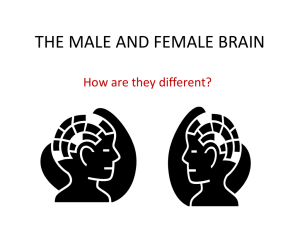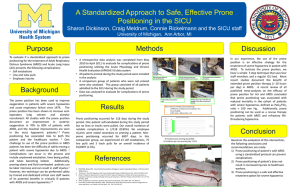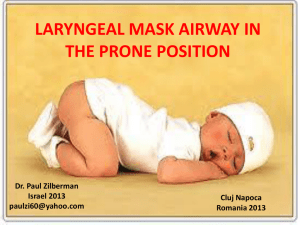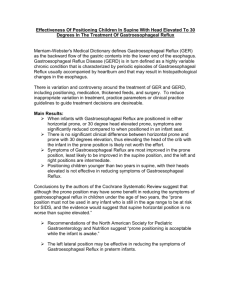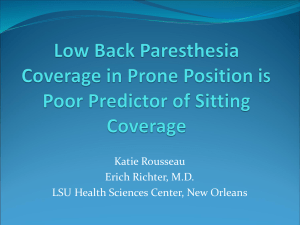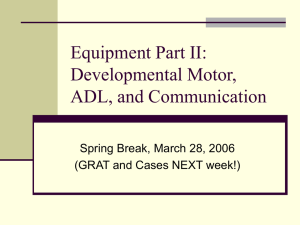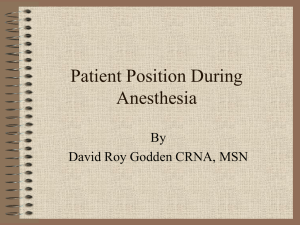Anesthesia in the Prone Position
advertisement
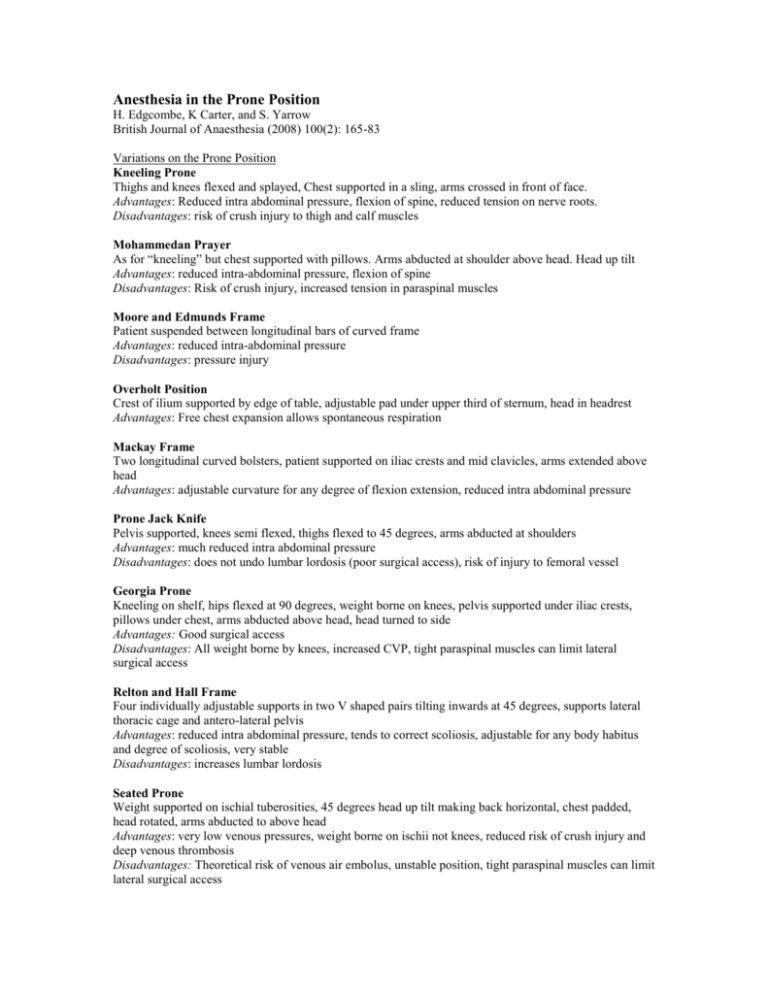
Anesthesia in the Prone Position H. Edgcombe, K Carter, and S. Yarrow British Journal of Anaesthesia (2008) 100(2): 165-83 Variations on the Prone Position Kneeling Prone Thighs and knees flexed and splayed, Chest supported in a sling, arms crossed in front of face. Advantages: Reduced intra abdominal pressure, flexion of spine, reduced tension on nerve roots. Disadvantages: risk of crush injury to thigh and calf muscles Mohammedan Prayer As for “kneeling” but chest supported with pillows. Arms abducted at shoulder above head. Head up tilt Advantages: reduced intra-abdominal pressure, flexion of spine Disadvantages: Risk of crush injury, increased tension in paraspinal muscles Moore and Edmunds Frame Patient suspended between longitudinal bars of curved frame Advantages: reduced intra-abdominal pressure Disadvantages: pressure injury Overholt Position Crest of ilium supported by edge of table, adjustable pad under upper third of sternum, head in headrest Advantages: Free chest expansion allows spontaneous respiration Mackay Frame Two longitudinal curved bolsters, patient supported on iliac crests and mid clavicles, arms extended above head Advantages: adjustable curvature for any degree of flexion extension, reduced intra abdominal pressure Prone Jack Knife Pelvis supported, knees semi flexed, thighs flexed to 45 degrees, arms abducted at shoulders Advantages: much reduced intra abdominal pressure Disadvantages: does not undo lumbar lordosis (poor surgical access), risk of injury to femoral vessel Georgia Prone Kneeling on shelf, hips flexed at 90 degrees, weight borne on knees, pelvis supported under iliac crests, pillows under chest, arms abducted above head, head turned to side Advantages: Good surgical access Disadvantages: All weight borne by knees, increased CVP, tight paraspinal muscles can limit lateral surgical access Relton and Hall Frame Four individually adjustable supports in two V shaped pairs tilting inwards at 45 degrees, supports lateral thoracic cage and antero-lateral pelvis Advantages: reduced intra abdominal pressure, tends to correct scoliosis, adjustable for any body habitus and degree of scoliosis, very stable Disadvantages: increases lumbar lordosis Seated Prone Weight supported on ischial tuberosities, 45 degrees head up tilt making back horizontal, chest padded, head rotated, arms abducted to above head Advantages: very low venous pressures, weight borne on ischii not knees, reduced risk of crush injury and deep venous thrombosis Disadvantages: Theoretical risk of venous air embolus, unstable position, tight paraspinal muscles can limit lateral surgical access Tuck position Very similar to Prayer position, hips flexed >90 degrees, head-down tilt Advantages: Low venous pressures, spinal flexion improves surgical access Disadvantages: risk of crush injury and DVT, tight paraspinal muscles can limit lateral surgical access. Hastings Frame As for “seated prone” wooden frame with adjustable seat Advantages: More stable than seated prone, degree of spinal flexion variable Disadvantages: venous pooling in legs Physiological changes in the prone position Cardiovascular Decreased cardiac Index When moving a patient into the prone position an almost universal finding is a decrease in CI. In one study 16 patients with cardiopulmonary disease were moved into the prone position and found to have an average decrease in CI of 24% which reflected a decrease in stroke volume, with little change to heart rate. MAP was maintained by an increased SVR and PVR was also increased in most patients. No changes were noted in mean right atrial or pulmonary artery pressures. The specific prone position used may influence these findings. If the position of the heart is at a hydrostatic level above the head and limbs it may cause reduced venous return to the heart and consequently a decreased CI. Decreased CI may also be attributed to increased intra-thoracic pressures causing a decrease in arterial filling, leading to an increase in sympathetic activity via the baroreceptor reflex in some positions. Another study has suggested that in addition to reduced venous return, left ventricular compliance may also decrease secondary to increased intra thoracic pressure leading to a decrease in CO. Anesthetic technique may also affect hemodynamic variables. One study compared TIVA with inhalational anesthesia and found a greater decrease in CI and increase in SVR on turning the patient prone with TIVA. Inferior vena caval obstruction Obstruction of the IVC is a well recognized complication of prone positioning and is exacerbated by any degree of abdominal compression leading to decreased cardiac output and increased bleeding, venous stasis, and consequent thrombotic complications. Respiratory Lung volumes There is a relative increase in functional residual capacity when a patient is moved from supine to prone position. FVC and FEV1 change very little. The increase in FRC seems to be related to a reduction of cephalad pressure on the diaphragm and the reopening of atelactatic segments. Distribution of pulmonary blood flow In the prone position, blood flow may be relatively uniform as gravitational forces are opposing rather than augmenting the regional differences in pulmonary vascular resistance Distribution of ventilation Redistribution of lung ventilation is a proposed mechanism by which gas exchange is thought to improve in the prone position. Findings suggesting a more even vertical distribution of ventilation in the position due to gravity are common but not universal and some authors have found ventilation to remain heterogeneous in the prone position. A recent review suggested that pulmonary vascular and bronchiolar architecture may be more important than gravity in supine and prone positions in determining ventilation and perfusion distribution. Complications associated with the prone position Injury to the central nervous system Injuries from arterial occlusion Turning a patient from the supine to the prone position should be performed carefully, avoiding excessive neck movement and allowing normal blood flow in the carotid and vertebral arteries. There is a case report of left internal carotid artery dissection in the literature that was thought to be due to unrecognized extension or rotation of the neck during positioning. Occlusion of the vertebral arteries has been reported in at least four cases. In one an asymptomatic stenosis of the distal right vertebral artery led to hypoperfusion of the brain after rotation or extension of the neck. The other three case reports involved patients with normal vascular anatomy and were thought to be due to temporary occlusion of the vertebral arteries in the prone position that led to stasis, thrombosis and subsequent embolism when the occlusion was released. As most of these cases involved positioning with the head rotated, it would seem prudent to maintain neutral neck alignment to minimize the risk of occluding the carotid or vertebral arteries. Injuries from venous occlusion Four patients who underwent cervical laminectomy in the prone position supported by chest rolls developed new neurological deficits immediately after the operation (two hemiparesis, one quadriparesis, and one paraparesis). It was thought that the use of chest rolls caused a degree of increased venous pressure which, when combined with mild arterial hypotension led to decreased perfusion pressure in the spinal cord and ischemia. Air Entrapment Entrainment of air into the cranial cavity is common after neurosurgical procedures and occurs in all operative positions. There is a case report of quadriplegia as a result of air entrapment into the spinal cord after posterior fossa exploration. It was thought to have occurred as a result of the head down prone position allowing entrapped air in the posterior fossa to pass through the foramen magnum. Cervical Spine Injury Excessive neck flexion in a patient undergoing an 8.5h operation in the ‘Concorde’ position with the neck flexed and the chin approximately one finger breadth from the sternum resulted in complete and permanent C5/6 sensory and motor deficit level after operation. This was presumed to result from overstretching of the cervical cord in a narrow spinal canal and bulging C/6 disc with consequent ischemia. Another patient undergoing lumbar spine surgery awoke with a T6 sensory level as a result of a prolapsed intervertebral disc at C6/7. Excessive neck extension together with the muscle relaxation of general anesthesia was blamed. Undiagnosed space occupying lesions Although rare, space-occupying lesions within the spinal canal or cranial cavity can become symptomatic as a result of prone positioning including spinal arachnoid cysts, spinal metastases, and frontal lobe tumors. In each case, the mechanism involved was uncertain but the temporal relationship to the prone position strongly implicates it. Altered CSF flow dynamics and epidural venous engorgement could have been responsible. Injury to the peripheral nervous system Peripheral nerve injury may occur in patients under anesthesia in any position and is thought to be the end result of nerve ischemia from undue stretching or direct pressure. Prone positioning may lead to a different pattern or frequency of injury than supine positioning. Frequency of peripheral nerve injury In one study of 1000 consecutive spinal operations in patients in 5 different surgical positions, somatosensory evoked potentials (SSEPs) were used as a surrogate for peripheral nerve injury. SSEP monitoring of the upper limbs found that the prone superman and lateral decubitus positions had the highest frequency of reversible SSEP changes at 7% and 7.5% respectively. The prone position with arms tucked at the side caused changes in 2.1% of patients. Overall SSEP changes occurred in 6.1% of patients, none of which developed a new neurological deficit after the operation. Distribution of peripheral nerve injuries At lease four cases have been reported of brachial plexus damage occurring after prone positioning intraoperatively. One of the patients sustained a bilaterial brachial plexus palsy after the arms had been extended in the prone position for spinal fusion. There have been case reports of ulnar neuropathy in the prone position as well as a single case report of axillary nerve injury attributed to arms being abducted above the head. Musculocutaneous and radial nerve injuries have also been reported. In the lower limb there is one report of sciatic nerve injury. Damage to the lateral cutaneous nerve of the thigh is a much more commonly recognized complication of prone positioning. A single report describes damage to the lingual and buccal nerves which were thought to have been stretched between masseter muscles as a result of inadvertent jaw retraction in the prone position. Three patients have sustained injury to the supraorbital nerve and over extension or rotation of the neck while prone is thought to have caused injury to the phrenic nerve and recurrent laryngeal nerve. Pressure Injuries Direct pressure injuries Pressure necrosis of the skin Direct pressure is a common cause of anesthesia related injury which can occur in the prone position. Close attention to positioning of the face, ears, breasts, genitalia, and other dependent areas to prevent pressure sores or skin necrosis has been advocated. Contact Dermatitis There is a report of a patient developing contact dermatitis after undergoing surgery with the head placed in the PronePositioner. This device is made of flexible polyurethane foam to support he face during prone surgery. The patient had undergone multiple procedures with the device and had become sensitized to it. There is also a case of contact dermatitis in response to a BIS monitor placed on the forehead thought to be exacerbated by the prone position. Tracheal compression There have been 4 reported cases of tracheal compression occurring in the prone position. In all patients this was associated with thoracic scoliosis and the proposed mechanism involved a reduced anterior-posterior diameter of the chest, which resulted in compression of the trachea between the spine and the sternum. In 3 or the 4 patients the problem was exacerbated by an underlying connective tissue defect of the trachea either Marfan’s syndrome or tracheomalacia. Salivary gland swelling Bilateral painful swelling of the submandibular glands after surgery in the prone position with the head rotated has been reported. The authors concluded that it probably resulted from stretching of the salivary ducts leading to stasis and acute swelling. Shoulder dislocation The distribution of pressure in the prone position can lead to anterior dislocation of the shoulder. Occasional isolated cases of shoulder joint pain have also been reported in a larger series of patients operated on in the prone position. Indirect pressure injuries Macroglossia and oropharyngeal swelling Three cases of macroglossia and oropharyngeal swelling have been described in the prone position. The first of which was a difficult intubation and it is difficult to say whether this occurred due to positioning or trauma to the oropharynx during tube placement. The second case involved no difficulty with intubation, swelling of the tongue and oropharynx occurred after surgery and required emergency tracheostomy. The proposed mechanism for macroglossia and oropharyngeal swelling suggests that excessive flexion of the head and the presence of a tracheal tube cause kinking and obstruction of the internal jugular vein in the neck which in turn obstructs venous drainage from the lingual and pharyngeal veins. A common feature of the reports is anatomical abnormalities of the skull base which might predispose to venous obstruction Mediastinal compression The chest wall is usually able to support the patient’s weight without compression of the structures within it. However this may not be the case with congenital anatomical abnormalities. There are reports of loss of cardiac output during surgical manipulations of the spine in patients with scoliosis. This was likely due to compression of the heart and great vessels. In pectus excavatum this is more pronounced. Visceral ischemia Hepatic ischemia with progressive metabolic acidosis and elevated LFTs has been described after prolonged surgery in the prone position. This was thought to be due to abdominal compression. Avascular necrosis of the femoral head There are 3 reports of patients undergoing decompressive surgery for spinal stenosis with a hypotensive anesthetic technique developing collapse of the femoral head. The cause was thought to be a combination of deliberate hypotension and increased venous pressure from the prone position. Peripheral vessel occlusion There are reports of compression of the axillary artery being detected by pulse oximetry or radial artery monitoring. In a patient positioned on a four post Relton Hall spinal frame, shifting of the pelvis laterally on the frame caused occlusion of the femoral artery leading to mottling of one leg and absence of the dorsalis pedis pulse. Repositioning restored normal blood flow. Limb compartment syndrome There have been 7 cases of compartment syndrome reported in the English literature and one in the French literature. In all eight the patients were undergoing spinal surgery in the prone position which involved flexion of the hips and knees. Six patients required fasciotomies and 3 experienced acute renal failure. It would seem that is this is associated with flexion of the hips and knees and resultant impaired blood flow. Ophthalmic Injury In 2003 the ASA postoperative visual loss (POVL) Registry based on clinical of POVL followed prone spinal surgery. The two injuries most commonly described are ischemic optic neuropathy and central retinal artery occlusion. Aetiology Prone positioning can lead to ophthalmic injury by direct external pressure by a headrest or other support apparatus on the orbital contents causing an increase in intraocular pressure which may lead to retinal ischemia and visual loss. This is usually linked with examination findings consistent with central retinal artery occlusion. Ischemic optic neuropathy is not associated with direct pressure and may be due to inadequate oxygenation of the optic nerve causing ischemic damage and failure of impulse transmission. Perfusion pressure to the optic nerve can be defined as the difference between MAP and intraocular pressure or venous pressure, whichever is the greater. Prone positioning tends to increase venous pressure and peak inspiratory pressure which in turn increase intraocular pressure. This increased orbital venous pressure, decreased choroidal blood flow and reduced outflow of aqueous humor could decrease perfusion pressure to the optic nerve head and contribute to ischemic optic neuropathy. Visual loss after prone anesthesia and surgery is often characterized by long surgical duration, large blood loss and administration of large volumes of clear fluids. Minimizing risk It is important to position the head to maximize venous outflow from the eye and hence minimize any impairment of ocular perfusion. It may also be the case that in high risk patients keeping the head above the heart by means of a slight head up tilt can reduce risk. Embolic complications Venous gas embolism Venous gas embolism may result from atmospheric air entrainment or accidental direct delivery of exogenous gas. Efforts to minimize abdominal compression and thus IVC pressure in the prone position can result in an increased negative pressure gradient between the right atrium and the veins at the operative site. This increases the risk of air entrainment. Risks are minimized by maintaining intravascular volume and pressure and positioning the surgical site dependent relative to the heart. Non gaseous embolism Reports also exist of fat, cement and bone fragment emboli. It is not clear in the latter cases whether the complications are specific to the prone position or would have resulted anyway from the nature of the surgery, regardless of the position. Practical Procedures Airway management A variety of problems with the tracheal tube may occur while a patient is prone. One report describes repeated obstruction of a tracheal tube after prone positioning as a result of bloody secretions draining under gravity from the right lower lobe. A case report of a tube obstructed by inspissated sputum plugs describes the use of an arterial embolectomy catheter to remove plugs by inflating the catheter balloon beyond the pug and withdrawing the catheter. Use of the LMA as a primary adjunct is controversial but it has been used effectively. The LMA has been placed after prone positioning with the patient positioning themselves awake. This may avoid other adverse events related to the prone position such as soft tissue and nerve injury or spinal destabilization, but runs the risk of inability to maintain an adequate airway once anesthesia is initiated. Cardiovascular procedures In the OR, central venous catheterization in the prone position has been described. A prospective study investigated transoesophageal atrial pacing and concluded that this technique can be performed effectively in the prone position. There are also several reports on the management of cardiac arrest in the prone patient. Conventional teaching has been that the patient should be returned to the supine position via the use of an additional table in the OR. However this may not always be possible, especially when there may be bulky surgical instrument protruding from the back. Chest compressions have been delivered successfully with the hands on the central upper back between the scapulae. A post cordial thump delivered between the shoulder blades to treat pulseless ventricular tachycardia has also been described. Defibrillation has been successfully undertaken using the anterior-posterior paddle position or paddle orientation on the left and right sides of the back. However, the use of posterior paddle positions may not deliver enough energy to the myocardium owing to the anterior displacement of the heart in the prone position and also increased transthoracic impedance with PPV. Biphasic shocks and anterior paddle or pad positioning has been recommended.
